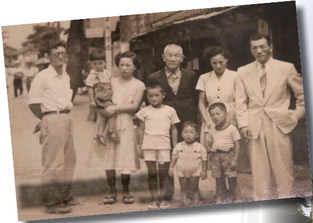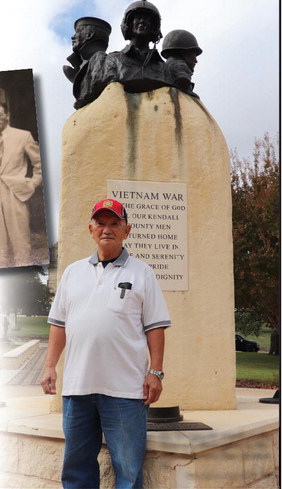BY JEFF B. FLINN Managing Editor
E iji Teragouchi carries a notebook teeming with the story of his life. The 81-year-old U.S. Army veteran served along the 38th parallel in Korea and then for a stint in Vietnam, between 1964-1966.
But the notebook contains little of his time there. Instead, photos, documents, maps, and illustrations capture life in the 1940s and 1960s in Hiroshima, Japan.
Teragouchi, born Sept. 2, 1942, in Koihonmachi, a section of Hiroshima, points to the spot in a photo where he was standing as a 3-yearold on Aug. 6, 1945, when the United States dropped the atomic bomb on Hiroshima.
“This is a picture, I was standing in the same spot that morning,” he said, a later photograph that captured the street and homes where he lived.
\\“Where I was standing that morning, I could see the fireball coming

Eiji Teragouchi ( youngest boy standing, left) poses with his parents and aunt and uncle in this photo from 1948 or 1949, taken in front of his family’s storefront and home in the Koihonmachi section of Hiroshima.
Courtesy photo

Eiji Teragouchi stands in the Veterans Plaza prior to the city’s Veterans Day ceremony. Star photo by Jeff B. Flinn toward the front of the store. In the meantime, because of where I was standing … watching the bright fire approach. My nextdoor neighbor’s grandmother picked me up and took me back to her storefront.”
Homes at that time were about 20 feet back from the street, with family stores or businesses occupying a front section along the street.
“When that moment happened, she took my back into the storefront. She was on her elbows and her knees, and I was underneath,” he said, dropping into a slight crouch in the office chair, mimicking his position that day, as all hell broke loose outside.
“Iwaswatching,andtheroofing started to come down,” he said, struggling just a bit to remember other details of the day.
All of Teragouchi’s family survived the blast, which incinerated an area 1.5 miles around the atomic bomb “drop dome.”
Kiohonmachi, across the Ota River from the industrial portion of the city, was hit and heavily damaged, but not to the extent of the buildings – and life – obliterated inside the 1.5-mile dome perimeter.
“I remember my mother and I walking down the street over her, walking toward the train station, the streetcar station. My mother had my hand and she said, ‘Just close your eyes, don’t look anywhere else,’” he recalled.
But being a typical kid, he laughed, he didn’t do what she said. He recalls seeing people who had been standing in the open area.
“The flash occurred … and that heat burned the skin off the people. It melted off,” he said. He remembers seeing people, their skin melting, peeling away from their bodies, begging for water.
While young Eiji escaped the initial devastation of the blast, the resulting radiation did him in.
“I understand I was sick, and fell into a coma,” he said. “My grandfather knew a lot of people, so he contacted a physician, and somehow they got some penicillin, and they gave it to me in my right thigh.”
He cannot remember exactly how long he was in a coma, but later recalled his mother telling him it was for several months. He said he never knew how much damage the family home sustained.
In 1953, the Teragouchi family returned to the United States – his father, Toshito, was born in Hawaii in 1912; his mother, Chiyoko, born in Newcastle, California, in 1920.
The family – Eiji was the oldest of three sons – arrived in Hawaii where his aunt lived, soon moving to Oxnard, California.
“I didn’t know one word of English at that time,” he recalled, as a 11-year-old.
Teragouchi eventually graduated from Oxnard High School and attended Ventura College for two years, hoping to become an engineer, when Uncle Sam came calling.
He was drafted into the U.S Army in 1964, shipping off to Fort Carson, Colorado, in April 1964 for 16 weeks of basic training and infantry school.
In January 1965 his unit was ordered to Korea while many of his classmates from Fort Carson were being shipped off to South Vietnam. “The United States had special forces in Vietnam at the time. About six months later, the first cavalry units were dispatched to Vietnam,” he said.
ThedocumentsTeragouchipossesses were organized as a result of his later career with Westinghouse. He had to present the birth certificates to the U.S. Atomic Energy Commission to prove he was a U.S. citizen.
He worked for Westinghouse’s Naval Reactor Division, designing verifications for nuclear ships and aircraft carriers. The first carrier he worked on was CVN68, the carrier naval vessel Nimitz. He also worked on the USS Eisenhower and USS Carl Vinson carriers.
Subsequent work took him to the Philippines before ending up in Bay City, Texas. Post-Westinghouse life included seven years in Phoenix, Arizona operating a home inspection business.
A final call from Westinghouse sent him to China from 2007-2008 before a short stint in Italy.
He and his family moved to Boerne in 2010 – wife Lorna, and daughters Linda and Erika – before he finally retired in 2014.
Teragouchi also is a 7th-degree black belt, first taking up judo in 1955 and earning his first black belt in 1965, while stationed in Korea.
He was certified as an international judo referee in 1975 and refereed many national and collegiate championshipsandmatches.
“Judo is my life,” he said, without hesitation. “I never have (had) PTSD; I think that helped me to avoid that.”







Comment
Comments